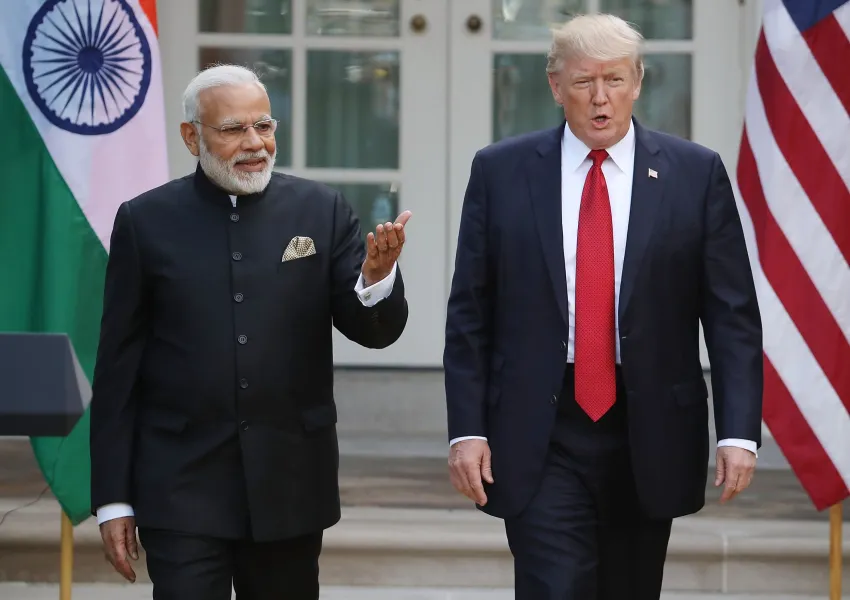14 Feb , 2025 By : Debdeep Gupta

Sensex and Nifty opened higher on February 14, buoyed by easing Russia-Ukraine war tensions, a delay in U.S. tariff impositions until April, favourable U.S. producer data, and Trump-Modi talks aligning with expectations. However, the gains were short-lived as the benchmarks turned flat soon after. This follows a seven-session losing streak driven by disappointing Q3 earnings, escalating U.S. tariff concerns, and persistent FII outflows.
At 9.50 AM, the Sensex was up 103 points or 0.1 percent at 76,242, and the Nifty was up 16 points or 0.07 percent at 23,047. About 1,012 shares advanced, 2,006 shares declined, and 117 shares were unchanged.
Aishvarya Dadheech, Founder & CIO of Fident Asset Management, highlighted four key global developments driving market sentiment.
First, the Russian rouble and stocks surged on February 13 after U.S. President Donald Trump and Russian President Vladimir Putin discussed ways to end the Ukraine war during a phone call, easing geopolitical tensions.
"Second, the expected noise about more tariffs, which was anticipated last night, has been deferred until April. They want to go through more data and take additional time, so there wasn’t too much negativity from Trump’s announcement," Dadheech noted.
Wall Street closed higher, with Nvidia, Apple, and Tesla leading gains, after Trump unveiled plans for reciprocal tariffs aimed at matching duties imposed by trading partners. A White House official indicated these tariffs could be introduced within weeks as the administration assesses bilateral trade dynamics.
According to Dadheech, U.S. inflation data was okay, contributing to positive sentiment.
U.S. stocks also gained after U.S. producer prices rose in January, while key elements in the core Personal Consumption Expenditures (PCE) index—a metric closely monitored by the U.S. Federal Reserve—remained benign. Prices for healthcare services, which make up nearly 20 percent of the core PCE, either stayed flat or rose slightly, helping ease inflation fears. Following the report, yields on the 10-year U.S. Treasury bond fell, reflecting growing investor confidence in cooling inflation.
Lastly, the meeting between Prime Minister Narendra Modi and Trump in Washington DC added to the market buzz and was "largely in line with expectations," according to Dadheech. Described by the PMO as "productive discussions," the meeting saw Modi open to talks on easing tariffs while exploring defence and trade deals. Modi's offer to discuss further tariff reductions eased concerns over reciprocal duties, especially for import-oriented sectors. He also expressed willingness to increase purchases of US oil, gas, and defence equipment. The two nations announced bold plans to strengthen strategic ties, particularly in defence and energy. Trump's offer to supply F-35 fighter jets to India as part of billion-dollar military deals underscores the growing partnership. Modi’s ambitious vision to double bilateral trade to $500 billion by 2030 set an optimistic tone.
The broader markets lagged behind the benchmarks, with both BSE Midcap and BSE Smallcap losing over 1 percent each.
Among sectoral indices, only Nifty FMCG managed to stay in the green, while the other 12 major sectors were in the red.
HUL, ITC, JSW Steel, ICICI Bank, and Hero MotoCorp led the gains on Nifty 50, rising 0.6-1 percent. In contrast, Adani Enterprises, Adani Ports, Dr Reddy's, Apollo Hospitals, and Sun Pharma were the biggest laggards, dropping 1-2 percent.
Deepak Nitrite shares tumbled 10 percent after its Q3FY25 net profit plunged over 50 percent to Rs 98 crore, compared to Rs 202 crore in the same period last year.
Asian markets tracked Wall Street's gains, while the dollar eased as investors processed the delay in Trump’s reciprocal tariffs and inflation data that soothed market concerns.
From a technical standpoint, Nifty 50 found support in the 22,900-22,800 zone, but any dip below this could disrupt the short-term technical setup, according to Sameet Chavan, Head of Technical and Derivative Research at Angel One. "Conversely, 23,250-23,350 is likely to be seen as an intermediate resistance zone, followed by significant obstacles around the 23,400-23,500 subzones."
0 Comment